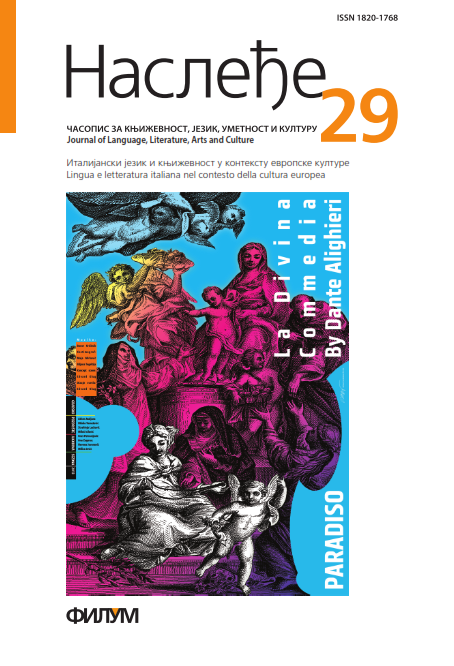ORTOGRAPHIC LEVEL OF THE ANALYSIS OF TRANSLATIONS FROM ITALIAN AS L2 TO MONTENEGRIN AS L1
On examples of translation tasks performed as part of written exams of the Italian language at the university level
Keywords:
translation, language skills, translation competence, translation errors, language errors, orthographic level, the university levelAbstract
The subject Translation from Italian into Montenegrin is part of the curriculum of the Undergraduate Degree Course at the Department of Italian Language and Literature (University of Montenegro). Although the main aim of translation exercises ‒ along with other language exercises ‒ is to improve learning and acquisition of language skills, they also serve to introduce students to the fundamentals of translation competence. In fact, since there are no professional translation schools or courses in Montenegro, the students of the Department of Italian Studies are taught and trained to become future translators, even though the professional title they achieve after the four-year study is Teacher of the Italian language and literature. These circumstances resulted in the need to conduct a research on the course of translation that takes place within the framework of the above-mentioned university programme, with the main goal to improve it and make it responsive to the needs that are being imposed thanks to the growing demand for translators and interpreters for the Italian language in Montenegro. The research was carried out on a corpus of more than a thousand tasks of translation of four generations of students of the second and third year of the Italian language and literature at the University of Montenegro. These were the translations offered to students within different written tests and examinations at the end of semester (starting from academic year 2009/2010 to 2012/2013) that have been analyzed on various linguistic levels ‒ orthographic, lexical, morphological, syntactic and textual.
The aim of the paper is to reveal and explain the origin of various types of errors in orthographic level of students’ translations by classifying them into two general categories: language errors and translation errors. In this way, the author tries to indicate the ‘weak points’ in acquiring both language competence (which is not concerning only the foreign language, but also the mother tongue) as well as the competence in translation.
The results of the research have confirmed our hypothesis that the majority of language errors found on the orthographic level of students’ translations are related to the negative transfer from Italian to the Montenegrin language. For this reason, the author has divided the paper into chapters that will discuss those segments in which the orthographic differences between these two languages are most pronounced. In this sense, this article may serve not only as a kind of practical handbook for students and translators, for language and translation teachers, but also as a source of comparative and contrastive observations between the Italian and Montenegrin languages.
References
Carreres 2006: A. Carreres, Strange bedfellows: Translation and Language teaching. The teaching of translation into L2 in modern languages degrees; uses and limitations. http://www.cttic.org/ACTI/ papers/Carreres.pdf, 03.03.2013.
Ceramella 2006: N. Ceramella, Translation Issues from a Didactical Perspective and Approaches to a didactic Methodology of Translation, in: Knežević M., Nikčević-Batrićević A. (eds), Reading Across Borders: papers in literary and language studies, Nikšić: Filozofski fakultet, 13-35.
Lazarević 2011: R. Lazarević, Uloga maternjeg jezika u (L1) u nastavi italijanskog jezika na univerzitetu, in: J.vučo, B. Milatović (priredile), Stavovi promjena – promjene stavova, Međunarodni tematski zbornik radova, Filozofski fakultet Nikšić, 177-182.
McCluskey 1987: B. McCluskey, The chinks in the armour: problems encountered by language graduates entering a large translation department, in: H. Keith and I. Mason (eds), Translation in the Modern Languages Degree. London: Centre for Information on Language Teaching and Research, 17-21.
Moderc 2004: S. Moderc, Gramatika italijanskog jezika. Morfologija sa elementima sintakse. Beograd: Udruženje nastavnika italijanskog jezika Srbije.
PACTE (2011) Results of the Validation of the PACTE Translation Competence Model: Translation Problems and Translation Competence, in: Methods and Strategies of Process Research: Integrative Approaches in Translation Studies, Amsterdam:JohnBenjamins. http://grupsderecerca.uab.cat/pacte/content/projectes-realitzats.
PCJ 2009: M. Popović, J. Silić, J. vasiljeva, Pravopis crnogorskoga jezika i rječnik crnogorskoga jezika (pravopisni rječnik), Podgorica: Ministarstvo prosvjete i nauke Crne Gore.
Klajn 2006a: I. Klajn, Rečnik jezičkih nedoumica, Novi Sad: Prometej.
Klajn 2006b: I. Klajn, P. Ivić, et al., Srpski jezički priručnik, Beograd: Beogradska knjiga.
Piletić 2010: D. Piletić, La traduzione nel corso di lingua italiana LS a livello universitario, in: E. Pirvu (a cura di), La lingua e la letteratura italiana in Europa (Atti del Convegno Internazionale di studi di Craiova), Editura Universitaria, Craiova, 226-237.
Piletić 2012: D. Piletić, Errori lessicali nelle traduzioni studentesche: Arena Romanistica - Journal of Romance Studies: Translation, University of Bergen, 254-278.
Piletić 2013: D. Piletić, Kontrastiranje sintaksičkih struktura italijanskog i crnogorskog jezika u službi nastave prevođenja: Riječ br.9, Filozofski fakultet Nikšić, (in stampa).
Rommel 1987: B. Rommel, Market-orientated translation training, in: H. Keith, I. Mason (eds), Translation in the Modern Languages Degree. London: Centre for Information on Language Teaching and Research, 11-16.
Samardžić 2008, M. Samardžić, Studentski prevod između školskog i profesionalnog ocenjivanja, in: J. vučo (priredila), Evaluacija u nastavi jezika i književnosti. Zbornik radova, Filozofski fakultet, Nikšić, 133-145.






